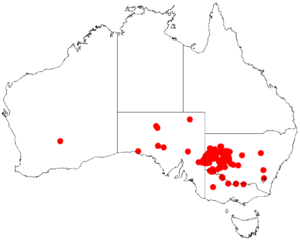Acacia loderi facts for kids
Quick facts for kids Acacia loderi |
|
|---|---|
| Scientific classification | |
| Genus: |
Acacia
|
| Species: |
loderi
|
 |
|
| Occurrence data from AVH | |
The Acacia loderi, also known as nelia or nealie, is a type of wattle tree. It is a native plant found in Australia.
Contents
Naming the Nelia
The Acacia loderi was first described in 1920 by a person named Joseph Maiden. It was named after A.C. Loder, who was an assistant forester. He collected the plant near Broken Hill in November 1907. The common names nelia and nealie come from the Ngyiyambaa word nhiil'i. This is the name the Ngyiyambaa people use for this plant.
What the Nelia Looks Like
The nelia grows as a large bush or a small tree. It can be about 3 to 8 meters (10 to 26 feet) tall. It can grow straight up or spread out. The bark of the tree is grey.
Like other wattle trees, the nelia has special leaf-like parts called phyllodes. These are not true leaves. The phyllodes are pale grey-green to green. They are very narrow and long. They can be 5 to 11 centimeters (2 to 4 inches) long. They are only about 0.9 to 2.5 millimeters (0.03 to 0.1 inches) wide. Bright yellow flowers appear on the tree in spring. This is usually from August to October.
Where the Nelia Grows
The Acacia loderi is found in the dry inland parts of southeastern Australia. You can mostly find it in far western New South Wales. It grows from White Cliffs in the north down to northwestern Victoria. It also spreads east to Hillston and west into eastern South Australia.
This tree likes to grow in brown or red soils. It is usually found in flat areas. The nelia is a very important part of a plant community called Acacia loderi shrubland. Here, it grows with other trees like black oak (Casuarina pauper). You might also see inland rosewood (Alectryon oleifolius) and leopardwood (Flindersia maculosa). The ground beneath these trees often has plants like chenopods and different grasses.
Why the Nelia is Special (and in Trouble)
The Acacia loderi shrubland is a very important natural area. Because of this, the New South Wales Government has listed it as an Endangered Ecological Community. This means it is a special group of plants and animals that is at risk.
The main problems for the nelia shrubland are two things. One is when land is cleared for other uses. The other is too much grazing by farm animals like cattle or sheep. These activities can harm the plants and their habitat.

